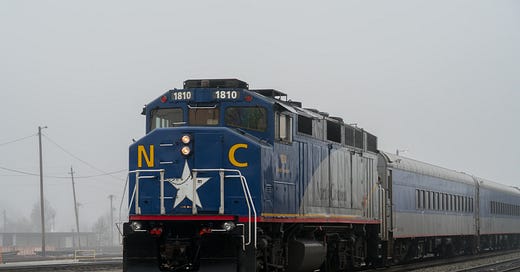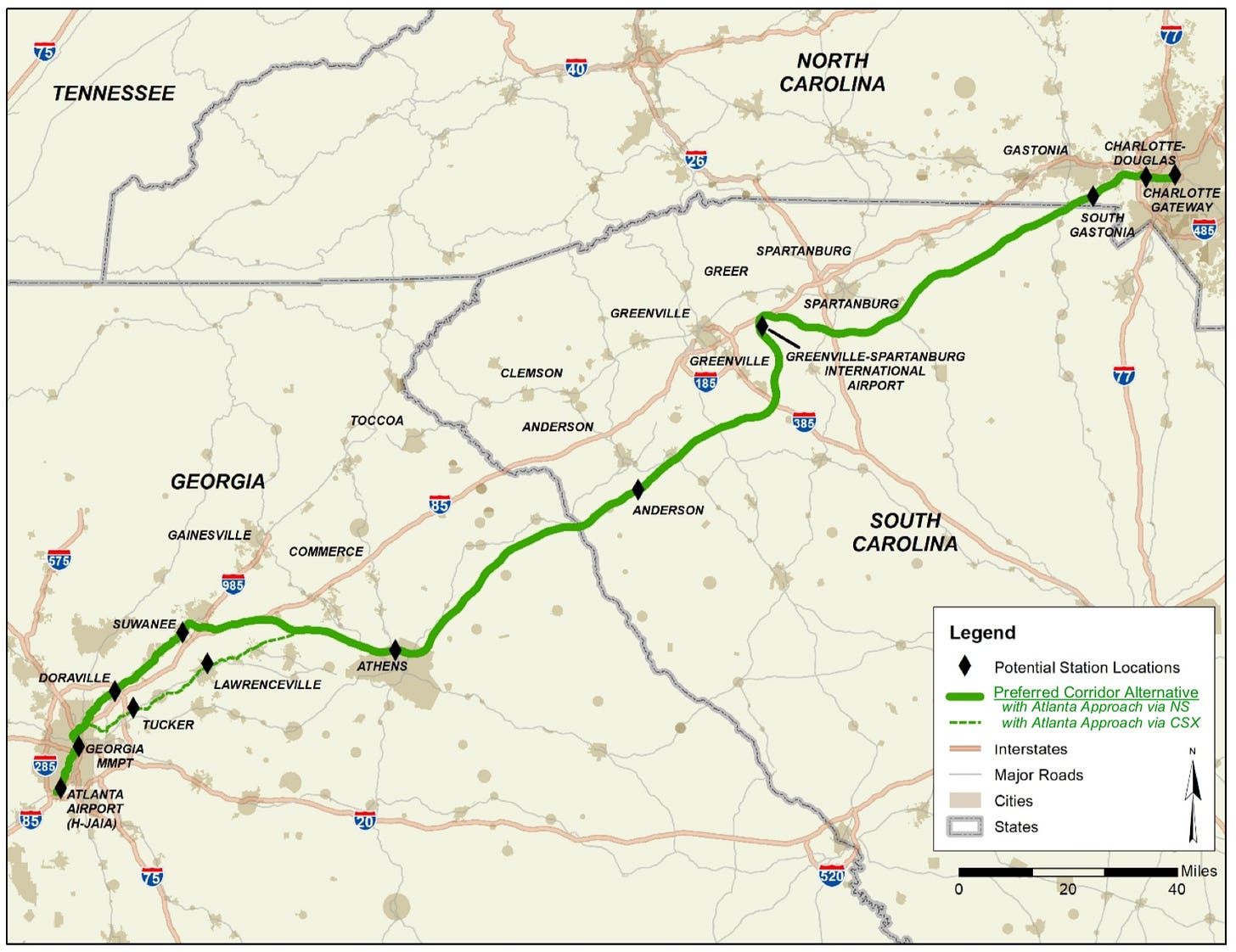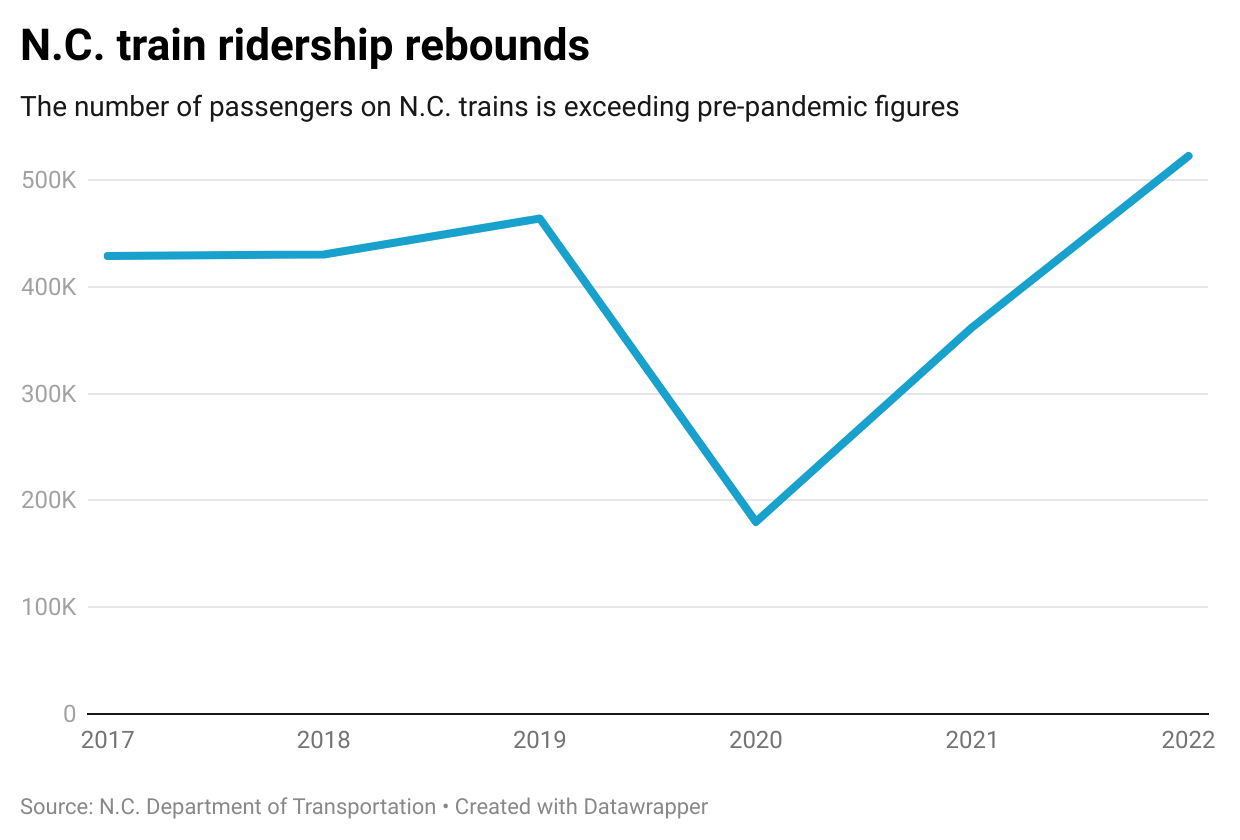How new federal funding is putting high-speed trains on track
NCDOT's rail director gives details on the possibility of new train service
You’re reading Transit Time, a weekly newsletter for Charlotte people who leave the house. Cars, buses, light rail, bikes, scooters … if you use it to get around the city, we write about it. Transit Time is produced in partnership between The Charlotte Ledger and WFAE.
Q&A: High-speed trains are many years and billions of dollars away. But this month they took the ‘very first step,’ NCDOT’s rail director says
Transportation officials want to build on the increasing popularity of passenger trains in North Carolina — like the Piedmont, seen here passing through Greensboro — by considering high-speed rail lines. (Shutterstock photo)
by Tony Mecia
The announcement last week of federal funding for high-speed rail in the Southeast generated plenty of excitement.
It conjured pleasant images of relaxing in a comfortable train seat with a book and occasionally dozing off, while zipping easily to Atlanta or Washington D.C. — and avoiding the hassles of fighting traffic and dodging unending construction and wrecks on interstates.
Charlotte Mayor Vi Lyles called the money “a massive leap in transforming how Charlotteans and North Carolinians travel.” Sen. Thom Tillis said the funding “could be transformational.”
But it didn’t sound like much money: There was $1.1 billion to expand 17 miles of track between Raleigh and Wake Forest (the town, not the university) — part of a possible future line between Raleigh and Richmond, which are 140 miles apart.
And there was $500,000 each for seven rail corridors involving North Carolina, including three from Charlotte:
Charlotte to Atlanta
Charlotte to Washington, D.C.
Charlotte to Kings Mountain
A 2021 study estimated the cost of a Charlotte-to-Atlanta line at up to $8.4 billion, so even if that projection is accurate, the latest contribution of $500,000 makes up just 0.006% of the cost.
To get some straight answers about what this federal money will do and what it won’t do, Transit Time talked this week with someone who knows what he’s talking about: Jason Orthner, rail division director with the N.C. Department of Transportation. He’s been in railroad project and program management with NCDOT for 23 years.
Orthner said it’s genuinely exciting that the federal government has identified corridors for high-speed rail development. But he also cautioned that, like other transportation projects, building new rail lines could take years and depends on funding that is not at all certain.
Here’s an excerpt from our conversation from this week, edited for clarity and length:
Q. What's the significance of this announcement?
Well, let me start out by saying for the Federal Railroad Administration, this is a first-of-its-kind program — a program that assists in the development of new intercity passenger rail corridors.
Up until this point, there really has been no formalized way of doing that. And it’s been kind of on a corridor-by-corridor basis and kind of ad hoc. This is intended to provide basically a pipeline of projects that will ultimately allow the FRA to track with the process of these corridors and help them get from this very early stage to what do we have to do to develop it — what do you need to do to actually develop this corridor?
This is really the very, very first step.
Q. Everybody wants to know: When are the trains going to start? What does the route look like? How much money is it going to cost? Do we know the answers to those questions?
The great thing about the program is it says, “Well, this corridor is now selected, so it doesn’t have to re-compete for being selected into the process.”
The timing of the development of the project really is more funding-dependent. Rail projects are not like highways and aviation, where there’s a federal funding formula that is provided to states to develop systems and networks. Rail funding is all competitive funding. And the first time we’ve ever seen federal funding at the levels that we’re seeing today is through the bipartisan infrastructure law passed in 2021, where there was actually substantial federal funding put into the process.
So really, the timing of the development of these projects is tied to when is the next authorization of surface transportation funding at the federal level? Because if they continue to be able to fund rail projects at the levels that we see in the current federal policy, then I think you could really start to see these things develop over the next 10 years.
But that really is the key: As they continue to wrestle with transportation policy at the federal level, is there funding there to support the development of these projects?
Q. And so what's the next step? Is it waiting for funding?
The step that we’re in right now is the scoping and development of the project. That’s what the half million is for.
You’re setting the base criteria: What is the service that we’re trying to develop here? Who are the parties we have to work with? What kinds of information do we need? You start the process of gathering that information and developing that sort of basic-level service plan that will lead into the next steps of more intensive project development.
Q. I'm sure no one's committing to any specific timeline here. But what is the typical timeline of development from just beginning to conceive of a project to actually finishing the project?
It can take 10 years or more to develop any individual project because of the different steps that you have to follow when using public funding.
For some less complex corridors, where you’re extending service on a current corridor, those steps can move a lot faster. But when you’re talking about all new, you’re talking about a longer period of time.
Q. How would you assess the complexity of Charlotte to Atlanta?
[A previous study] identified that they weren’t going to use that existing corridor, which is a very heavily used freight corridor with a lot of sharp curves. So to create a corridor that meets both the need for reliability and speed and frequency between two major urban areas like Charlotte and Atlanta, that study concluded you really needed to create a new alignment, and that does obviously create a lot of complexity, because that means you’re talking about building a corridor where one doesn’t exist.
A 2021 study led by the Georgia Department of Transportation suggested a route (in green, above) for high-speed train service between Charlotte and Atlanta on new tracks, with stops including Greenville-Spartanburg International Airport; Anderson, S.C.; Athens, Ga. and several in the Atlanta area. The study estimated the cost to build the line at between $6.2 billion and $8.4 billion, and the trip would take between 2 hours, 6 minutes and 2 hours, 44 minutes. (Image from “Atlanta to Charlotte Passenger Rail Corridor Investment Plan.”)
Q. Is there a rule of thumb about how much it costs per mile to lay new tracks? I’m guessing if you're going through Greenville, for example, the cost of acquiring land in an urban area is going to be higher than it is in rural areas.
If you’re on an identified corridor where we have the right-of-way, those costs are much more known. Obviously, there’s variability there due to inflation and things like that, and just variability in construction pricing.
There’s no specific rule of thumb, especially when we’re talking about developing a new corridor. With any large project, as you refine the details, you’re going to find a lot of other things that need to be considered. Costs can change.
Q. One of the other things that was announced was the Raleigh-to-Richmond line. It was $1.1 billion for improving 17 miles of track between Raleigh and Wake Forest. If it costs a billion dollars to go 17 miles on an existing track where you already have some right-of-way, and you’re talking about going from Charlotte to Atlanta — is that a good gauge of how much generally something can cost?
A lot of the cost with that project is you’re trying to get out of an urban area. So I think on a per-mile cost, that that’s obviously because its urban nature is very challenging. But then as you get outside of urban areas, the cost per mile is much less.
Q. One of the other corridors was Charlotte to Kings Mountain. What's the thinking on that? I haven't heard people in Charlotte say, “Oh my gosh — We really need a better way to get to Kings Mountain.”
Charlotte to Kings Mountain really is a consideration for a future extension of service. That one is very early in the process, and it’s going to take a lot of analysis to see what that means.
Kings Mountain is basically the last urbanized area in North Carolina before you head into South Carolina. And because it’s a consideration for an extension of service, it’s already got enough components to support the longer-distance intercity network that we’re developing.
So it’s not that Kings Mountain was the absolute endpoint that we’re trying to reach. It just became a logical extension of the urban area of Charlotte for current services.
North Carolina trains carried more than 500,000 passengers in 2022, the most in the 32-year history of the service, the N.C. Department of Transportation says. It added a fifth daily train between Charlotte and Raleigh in July.
Q. The third $500,000 grant was for service between Charlotte and Washington, D.C. What does that do?
Charlotte to D.C. is the core of the Southeast Corridor and then considers routing along the S-line, Raleigh to Richmond. The focus there is to create a backbone of the network that all these other services can connect to and ultimately that gets extended as well to Atlanta. … The goal there is to create a corridor that doesn’t have a lot of competing freight traffic on it.
Q. This doesn’t directly affect Charlotte, but another corridor that was approved was Asheville to Salisbury. What’s the idea there?
It really represents Western North Carolina as a whole. We just finished a study last week on that route. There’s a tremendous amount of demand — not just for Asheville, but for the communities in between Salisbury and Asheville. It’s a logical extension of the network to reach the populations that are along that I-40 corridor.
The N.C. Department of Transportation envisions expanding rail service in the coming years. The pink lines represent potential new routes, although not all were approved for study by the federal government.
Q. What would you say to someone who saw this announcement last week and says, “Yay! This is great! I'm so looking forward to taking high-speed rail to Atlanta!” How would you characterize the state of where things are in building out this high-speed network?
Transportation projects take a long time to deliver. The exciting thing is that selection under this program means that there will definitively be a process of analysis — that as long as funding continues, these projects are in the pipeline now and can continue along the process of getting to actual construction and operation.
So that really is the exciting news.
Transit Time is a production of The Charlotte Ledger and WFAE. You can adjust your newsletter preferences on the ‘My Account’ page.
Did somebody forward you this newsletter and you need to sign up? You can do that here:
Other affiliated Charlotte newsletters and podcasts that might interest you:
The Charlotte Ledger Business Newsletter, Ways of Life newsletter (obituaries) and Fútbol Friday (Charlotte FC), available from The Charlotte Ledger.
The Inside Politics newsletter, available from WFAE.









